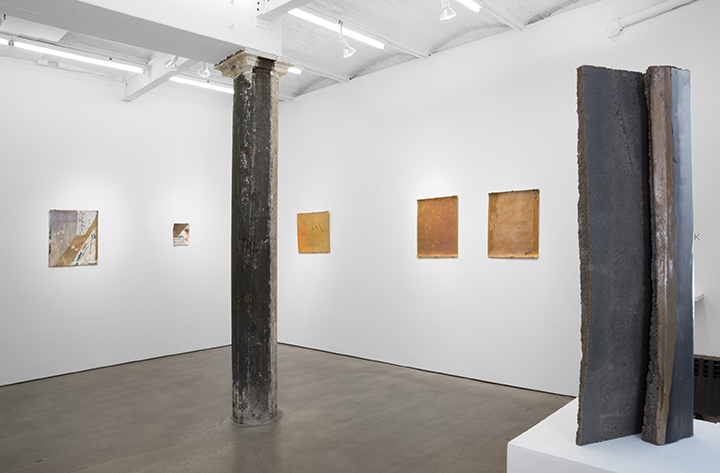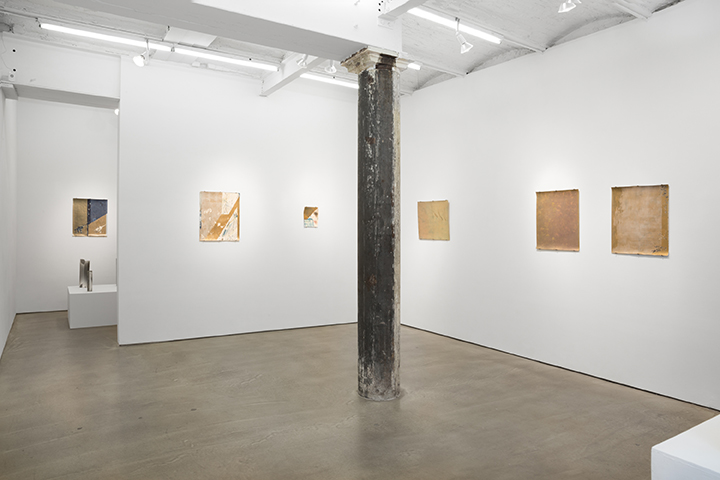Nikolai Ishchuk, Penumbra @Denny
By Loring Knoblauch / December 15, 2015
JTF (just the facts): A total of 10 photographic prints and 5 photographic sculptures displayed in the two room gallery space, the prints hung unframed and held to the white walls with nails and the sculptures shown on pedestals. All of the prints are gelatin silver prints, with additional cyanotype, acrylic, oil stick, printing ink, cement wash, and polymer spray, made in 2014 and 2015. Physical sizes range from 11×9 to 24×20 or reverse and all of the works are unique. The sculptural works are made of gelatin silver prints, fiber-reinforced concrete, cyanotype, acrylic, epoxy, and lacquer, and were made in 2014 and 2015. Physical sizes range of these works from 11x3x2 to 24x9x2 and all are unique. (Installation shots below.)
Comments/Context: Nikolai Ishchuk’s newest show picks up right where his last one (reviewed here) left off, so much so that the two gallery shows seem part of the same evolving continuum of ideas. For the past few years, both Ishichuk’s two and three dimensional works have considered a photograph as an elementary starting point, an object onto which additional process steps can be incrementally piled, ultimately leading to works that are only distant echoes of their original representational selves. And while his newest works might seem to be pulling photography even further away from its traditional aesthetic center, the pictures continue to be grounded in many of the chemical processes that turn light into imagery.
In his Sedimentation series, Ishchuk starts with a black and white photograph and then uses a series of overpainting steps to iteratively obscure the original, like the thin layers of dirt the title implies. In some works, this overpainting is done via screen print or monotype, the entire surface skimmed over with coppery paint, chalky cement wash, or blue cyanotype, often creating stuttering image reverberations and ghosts that recur in each layer. In others, the overpainting is more expressive (with wilder sweeps and drips) or geometric (with precise angular formations and lines) or both, intermingling rigid alignment with loose chance markings. And in one particular work, the underlying photograph of wood siding becomes the compositional basis for repeated folds across the surface of the paper, which are then washed over by encroaching white paint. In each case, Ishichuk is constructively concealing the primary image, cloaking it in flourishes that gather like veils.
The interventions in Ishchuk’s Spill series are less intrusive, allowing more of the underlying image to remain visible. Grassy weeds and a mountainous valley scene provide the substrates for watery cyanotpe rivers that wander and pool over the surface of the images, creating blue trails that seem to follow the natural flow of the underlying land, with milky cement washes providing an additional layer of misdirection. Here, the cyanotype chemicals aren’t capturing photographic imagery, but are an agent of expression in and of themselves.
Ishchuk’s sculptural forms use wispy photographic light leaks as a foundation, making them the most abstract of the works on view. Shadowy paper prints have been wrapped around concrete molds, adding gradients of white to grey or grey to black to triangles, rectangles, and other girder-like polygons. The coppery metallic paint we saw before returns here once again, adding an element of surface confusion to the rough material. The contrast between the weightless light captured in the imagery and the heavy concrete exerting its physical presence gives these sculptures a sense of uneasy balance, the light gently bending around the corners and edges.
This show is evidence of slow refinement and patient extension rather than frame-breaking artistic change. Ishchuk is methodically expanding his palette of techniques, allowing each successive project to build on the last, every step adding something new to his ongoing reconsiderations of photography. As he pushes further into three dimensions, his unexpected combinations of ethereality and weight are getting more sophisticated and nuanced.
Collector’s POV: The works in this show are priced as follows. The prints range from $1600 to $3500 while the sculptures are either $4000 or $5000, based on size. Ishchuk’s work has little secondary market history, so gallery retail remains the best option for those collectors interested in following up.



